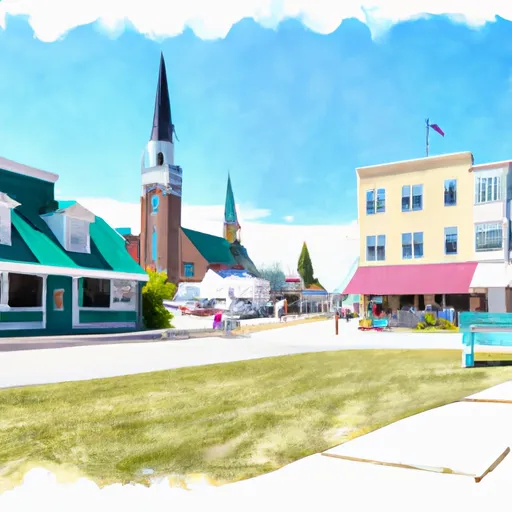-
 Snoflo Premium
Snoflo Premium
Get unlimited access to all our content
With no Ad interruptions! - Start Your Free Trial Login with existing account
Mackinaw-City
Eden Index
Climate
6.3
•
Recreation
6.9
•
Community
0.9
•
Safeguard
5.1/10

Mackinaw City is a charming town located at the northern tip of Michigan's Lower Peninsula, offering a great mix of natural beauty and historical significance. The climate in Mackinaw City is characterized by warm summers and cold, snowy winters. Average temperatures range from 20°F (-6.7°C) in winter to 75°F (23.9°C) in summer, making it an ideal destination for both winter sports and summer activities.
The town is situated near the Straits of Mackinac, where Lake Michigan and Lake Huron meet. This hydrological feature provides stunning views of the lakes and offers various water-based recreational opportunities such as boating, fishing, kayaking, and swimming. The Straits of Mackinac are also famous for their strong currents, attracting divers to explore shipwrecks in the area.
Outdoor enthusiasts can enjoy an array of activities in Mackinaw City, including hiking, biking, and camping in nearby state parks like Wilderness State Park. Visitors can also explore the iconic Mackinac Bridge, go on scenic cruises, or take a ferry to Mackinac Island to experience its historic sites and picturesque landscapes.
In summary, Mackinaw City offers a diverse range of outdoor recreational opportunities, stunning hydrological features, and a climate that caters to both winter and summer activities, making it an appealing destination for nature lovers and history enthusiasts alike.
What is the Eden Index?
The Snoflo Eden Index serves as a comprehensive rating system for regions, evaluating their desirability through a holistic assessment of climate health, outdoor recreation opportunities, and natural disaster risk, acknowledging the profound impact of these factors on livability and well-being.
Climate Health Indicator (CHI): 6.3
Mackinaw-City receives approximately
724mm of rain per year,
with humidity levels near 83%
and air temperatures averaging around
7°C.
Mackinaw-City has a plant hardyness factor of
5, meaning
plants and agriculture in this region thrive during a short period during spring and early summer. Most
plants will die off during the colder winter months.
By considering the ideal temperature range, reliable water supplies, clean air, and stable seasonal rain or snowpacks, the Climate Health Indicator (CHI) underscores the significance of a healthy climate as the foundation for quality living.
A healthy climate is paramount for ensuring a high quality of life and livability in a region, fostering both physical well-being and environmental harmony. This can be characterized by ideal temperatures, reliable access to water supplies, clean air, and consistent seasonal rain or snowpacks.
Weather Forecast
Streamflow Conditions
Northeastern Lake Michigan
Area Rivers
Northeastern Lake Michigan
Snowpack Depths
Northeastern Lake Michigan
Reservoir Storage Capacity
Northeastern Lake Michigan
Groundwater Levels
Recreational Opportunity Index (ROI): 6.9
The Recreational Opportunity Index (ROI) recognizes the value of outdoor recreational options, such as parks, hiking trails, camping sites, and fishing spots, while acknowledging that climate plays a pivotal role in ensuring the comfort and consistency of these experiences.
Access to outdoor recreational opportunities, encompassing activities such as parks, hiking, camping, and fishing, is crucial for overall well-being, and the climate plays a pivotal role in enabling and enhancing these experiences, ensuring that individuals can engage in nature-based activities comfortably and consistently.
Camping Areas
| Campground | Campsites | Reservations | Toilets | Showers | Elevation |
|---|---|---|---|---|---|
| Brimley State Park | 235 | 628 ft | |||
| Soldier Lake Rec Area | 43 | 908 ft | |||
| Crescent Lake - Lake Superior Provincial Park | 20 | 1,184 ft | |||
| Agawa Bay - Lake Superior Provincial Park | 147 | 620 ft | |||
| Monocle Lake Rec Area | 39 | 641 ft | |||
| Rabbit Blanket Lake - Lake Superior Provincial Park | 60 | 1,126 ft | |||
| Carp River | 38 | 632 ft | |||
| Beach - Pancake Bay Provincial Park | 236 | 614 ft | |||
| Bay View | 24 | 622 ft | |||
| Hilltop - Pancake Bay Provincial Park | 89 | 657 ft |
Nearby Ski Areas
Catastrophe Safeguard Index (CSI):
The Catastrophe Safeguard Index (CSI) recognizes that natural disaster risk, encompassing floods, fires, hurricanes, and tornadoes, can drastically affect safety and the overall appeal of an area.
The level of natural disaster risk in a region significantly affects safety and the overall livability, with climate change amplifying these risks by potentially increasing the frequency and intensity of events like floods, fires, hurricanes, and tornadoes, thereby posing substantial challenges to community resilience and well-being.
Community Resilience Indicator (CRI): 0.9
The Community Resilience Indicator (CRI) recognizes that education, healthcare, and socioeconomics are crucial to the well-being of a region. The CRI acknowledges the profound impact of these elements on residents' overall quality of life. By evaluating educational resources, healthcare accessibility, and economic inclusivity, the index captures the essential aspects that contribute to a thriving community, fostering resident satisfaction, equity, and social cohesion.

